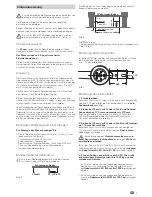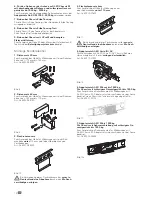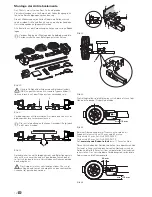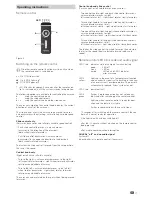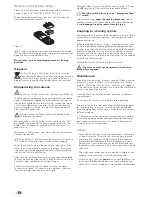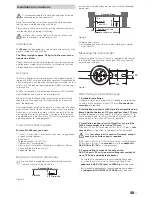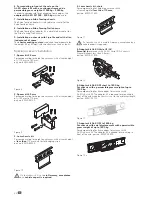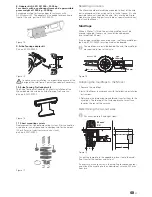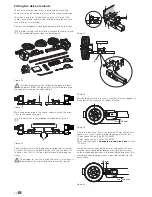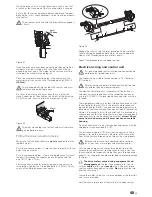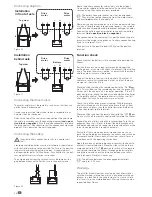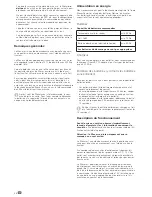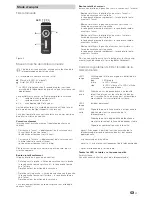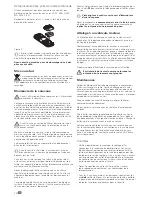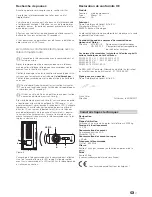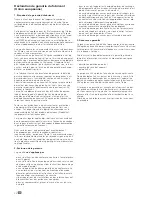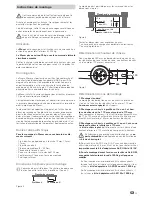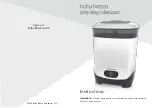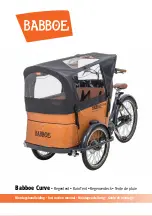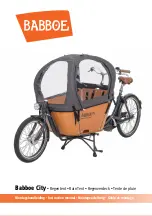
18
Remote control battery change
Please only use leak-proof micro-batteries with a steel outer
casing, type LR 03, AAA, AM 4, MN 2400 (1.5 V).
When inserting new batteries, take care not to reverse the
positive and negative terminals!
Figure 3
Empty, used batteries can leak and damage the remote
control! Remove the batteries if the remote control is not
being used for a long period of time.
No warranty is given for damage caused by leaking
batteries.
Disposal
Neither the remote control nor the batteries may be
disposed of with domestic refuse, instead they must be
sent for recycling separately via a collection point. By
doing this you are contributing towards reuse and recycling.
Manoeuvring the caravan
Follow the “Safety instructions” before using the Mover!
With the caravan uncoupled (apply parking brake and secure
against rolling away) engage the drive rollers on the tyres us-
ing the lever provided. Turn the lever until it cannot be turned
any further without excessive force. In the end position the
drive unit engages securely. This must be checked on both
sides before manoeuvring.
Before starting the Mover, release the parking brake
and remove the chocks.
Move the slide switch (a) on the remote control to the “On”
position – the green LED flashes in combination with the
audio signal for approx. 5 seconds until the control unit is
ready for use.
Movement in all directions is possible using the control knob
and the slide control.
The Softstart / Softstop makes the caravan start to move
without jolting, and brakes it gently when stopping.
When the control knob or slide control are released, or if the
radio signal is interrupted or becomes too weak, the caravan
stops moving. Radio equipment and other Moverremote con-
trols will not activate your Mover.
After start-up, the Mover moves at a steady speed (according
to the setting on the slide control). Speed increases slightly on
downhill slopes and decreases on uphill slopes.
System factors mean that the speed increases on slopes.
To reduce the speed, it is necessary to stop often (slide con-
trol in the idle position) and then start again.
Move the slide switch on the remote control to the “Off” pos-
ition
to switch off the remote control and the Mover.
The slide switch also acts as an “Emergency Stop”
switch.
After manoeuvring,
apply the parking brake first
and se-
cure the caravan with chocks to prevent it from rolling away,
then
disengage the drive rollers from the tyres.
Coupling to a towing vehicle
The Mover allows a caravan to be coupled to a towing vehicle
with millimetric precision. However, this requires care and a
degree of practice.
Following the operating instructions, move the caravan close
to the towing vehicle (apply parking brake and engage gear).
In order to position the caravan precisely, operate the control
knob or slide control until the caravan’s coupling is located
precisely over the ball coupling on the towing vehicle. Then
couple the caravan to the vehicle by lowering it at the support
wheel in the usual manner.
Prepare the caravan for towing in the usual way.
The caravan must not be towed with the drive
rollers engaged.
Maintenance
Keep drive elements clear of coarse road dirt. When cleaning
the caravan, spray the Mover with a water hose to remove
mud etc. Make sure that no stones, twigs etc. are trapped in
it. The control unit does not require servicing. The remote con-
trol must be kept in a dry place.
Clean the Mover as described above every year (or before
overwintering).
Do not park the caravan with the drive rollers engaged.
To prevent the battery from becoming totally discharged dur-
ing long periods of inactivity, it must be disconnected and
then recharged from time to time. Charge the caravan battery
before starting up.
It is extremely easy for you or your caravan dealer to perform
the checking and maintenance of your Mover during the an-
nual inspection of your caravan. If in doubt, please contact
Truma Service (www.truma.com).
Checks
– Check the installation, wiring and connections for damage
at regular intervals. The drive units must be able to move
freely, and the spring must automatically return them to
the safe idle position when they are disengaged. If this is
not the case, check the drive units for dirt or corrosion on
their guides, and if necessary have them cleaned by trained
specialists.
– After the annual inspection, check whether all motors react
properly to the commands from the remote control.
– At least every 2 years, an
expert
must check the Mover for
rust, check that detachable parts are firmly attached and
check that all safety-related parts are in good working order.






